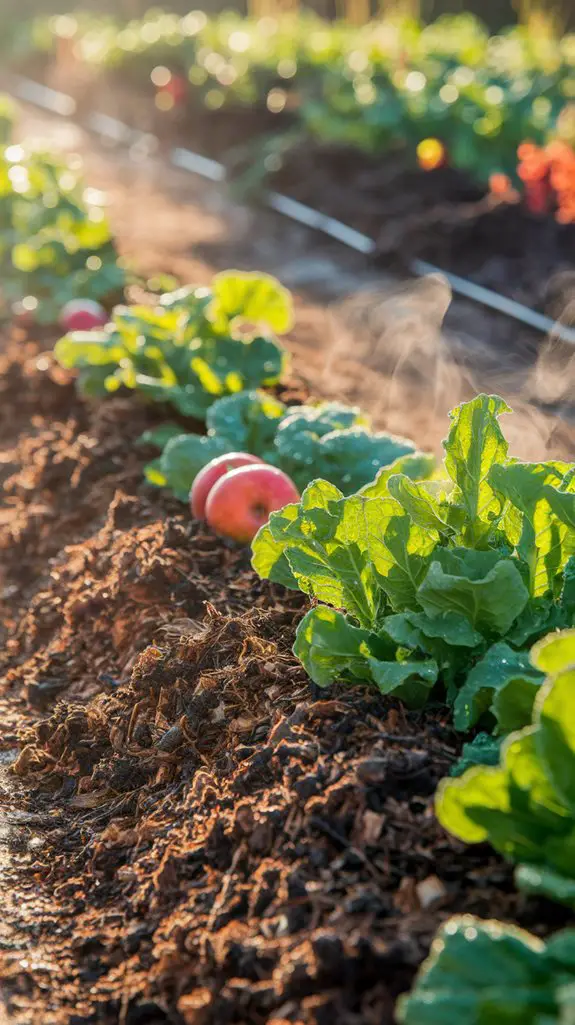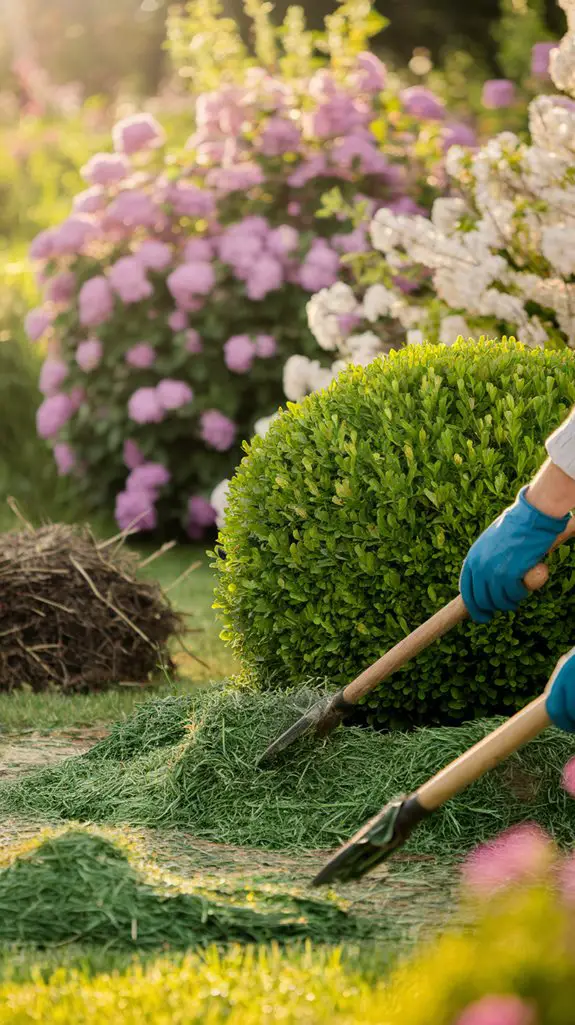Picture your garden soil wrapped in a protective blanket that nurtures plants while caring for our planet. You’ll find that eco-friendly mulching transforms your gardening practice by reducing water use, suppressing weeds, and building healthier soil—all while repurposing materials that might otherwise end up in landfills. From kitchen scraps to fallen leaves, nature provides everything you need to create a sustainable growing environment that works with ecological cycles rather than against them.
Why Choose Environmentally Friendly Mulch for Your Garden
When you select eco-friendly mulch for your garden, you’re making a choice that benefits both your plants and the planet.
Conventional mulches often contain dyes, chemicals, and non-renewable materials that can leach into soil and harm beneficial organisms.
Sustainable mulch options reduce waste by repurposing natural materials that would otherwise end up in landfills.
They break down gradually, enriching your soil with organic matter and nutrients while supporting healthy microbial activity. This improves soil structure, enhances moisture retention, and boosts plant immunity naturally.
Additionally, eco-friendly mulches help sequester carbon, reduce water usage, and decrease the need for synthetic fertilizers and pesticides.
Compost as a Nutrient-Rich Mulch Alternative

Unlike traditional wood mulches that primarily conserve moisture and suppress weeds, compost serves as both a protective layer and a dynamic nutrient delivery system for your garden.
As organic materials break down, they release essential nutrients directly into your soil profile, enhancing microbial activity and improving soil structure simultaneously. Additionally, compost can help control weed growth naturally by providing a dense layer of organic material that prevents sunlight from reaching weed seeds.
You’ll find several advantages when using compost as mulch:
- Introduces beneficial microorganisms that create healthy, living soil ecosystems
- Gradually releases nitrogen, phosphorus, and potassium in plant-available forms
- Improves soil water retention while allowing proper aeration and drainage
- Recycles kitchen and yard waste, creating a closed-loop system in your garden
Apply compost in a 1-2 inch layer around plants, rejuvenating it seasonally as it incorporates into the soil beneath, continually feeding your plants through natural decomposition processes.
Grass Clippings and Lawn Trimmings for Zero-Waste Gardening

Many gardeners overlook one of the most abundant and free mulching resources available right in their own yards. Grass clippings and lawn trimmings create excellent mulch that embodies zero-waste principles while providing substantial benefits to your garden beds.
When using lawn clippings as mulch, apply them in thin layers (1-2 inches) to prevent matting and decomposition issues. Fresh clippings contain approximately 4% nitrogen and break down quickly, feeding your soil as they decompose.
Verify clippings come from lawns that haven’t been treated with herbicides or pesticides, as these chemicals can harm your garden plants.
For best results, let clippings dry slightly before application to prevent clumping. You’ll find they’re particularly effective around vegetables, annual flowers, and between garden rows where their quick decomposition cycle supports active growing seasons.
Leaves and Leaf Mold: Nature’s Perfect Ground Cover
What Are Eco-Friendly Mulch Options for Gardens?
Leaves and Leaf Mold: Nature’s Perfect Ground Cover
Fall’s bounty of leaves represents one of the most valuable and overlooked resources for garden mulch. Rather than bagging and disposing of this natural windfall, you’ll benefit from collecting and using these carbon-rich materials throughout your garden.
Leaves break down into leaf mold—a dark, crumbly material that improves soil structure and retains moisture.
- Fresh shredded leaves provide immediate weed suppression and protect soil from temperature extremes
- Partially decomposed leaves feed beneficial soil fungi that help plants access nutrients
- Leaf mold can hold up to 500% of its weight in water, reducing irrigation needs
- Using fallen leaves as mulch completes nature’s nutrient cycle and prevents methane emissions from landfills
You can accelerate decomposition by shredding leaves with a mower before application. Additionally, effective mulching methods can enhance the benefits of using leaves, ensuring your garden thrives throughout the seasons.
Straw and Hay Mulch for Vegetable Gardens
When properly sourced and applied, straw and hay offer vegetable gardeners exceptional mulch options that combine practicality with ecological benefits.
Straw mulch (seedless stems) creates a protective barrier that suppresses weeds while allowing water to penetrate easily to plant roots.
You’ll find straw particularly beneficial around tomatoes, peppers, and cucumbers, keeping fruits clean and preventing soil-borne diseases. Opt for certified weed-free straw whenever possible to avoid introducing unwanted seeds.
Hay contains more nutrients but also more seeds. It breaks down faster than straw, enriching your soil with nitrogen and organic matter.
Apply a 2-4 inch layer around plants, keeping it slightly away from stems to prevent rot. Both materials will gradually decompose, improving soil structure and feeding beneficial microorganisms.
Recycled Wood Chips and Bark: Sourcing Sustainable Options
Wood chips and bark mulch from recycled sources represent one of the most sustainable choices for eco-conscious gardeners, turning what would otherwise be waste into valuable garden resources.
You’ll find these materials readily available from arborists, municipal composting programs, and tree service companies that chip removed trees.
When sourcing sustainable wood mulch, consider:
- Look for Forest Stewardship Council (FSC) certified products if purchasing commercially
- Avoid mulch treated with synthetic dyes or chemicals
- Request untreated, local hardwood chips from arborists for ideal soil health
- Verify your source isn’t using diseased trees that could spread pathogens
These recycled products break down more slowly than other organic mulches, providing long-term soil protection while sequestering carbon and gradually releasing nutrients as they decompose. Additionally, using sustainable landscaping ideas can enhance the overall health and vitality of your garden.
Living Mulches: Ground Covers That Serve Multiple Purposes
Living mulches represent a dynamic alternative to traditional mulch materials, functioning as both soil cover and active contributors to your garden ecosystem. Unlike static mulches, these ground-covering plants actively suppress weeds while improving soil structure through their root systems.
Low-growing herbs like creeping thyme and oregano work beautifully between vegetables or along pathways, releasing aromatic oils that deter certain pests. Clover fixes nitrogen, enriching soil fertility as it grows.
For ornamental beds, consider drought-resistant sedum or native violets that provide habitat for beneficial insects.
You’ll find living mulches reduce water evaporation while eliminating the need for frequent mulch replacement. Choose species compatible with your climate and primary plants to avoid competition. Additionally, embracing companion planting techniques can further enhance the benefits of your living mulch by fostering synergistic relationships between plants.
The best options serve multiple purposes: conserving moisture, controlling erosion, supporting pollinators, and enhancing biodiversity.
Application Methods for Maximizing Mulch Benefits
Proper application techniques guarantee your mulch delivers maximum ecological benefits while minimizing potential drawbacks. Always apply mulch when soil is moist and weeds have been removed.
Create a 2-3 inch layer for organic mulches, but avoid direct contact with plant stems to prevent rot and pest issues.
- Spread mulch in concentric circles around trees, leaving a 3-inch gap around the trunk to prevent “mulch volcanoes” that damage bark.
- Water thoroughly after application to help settle materials and prevent dry pockets.
- Replenish organic mulches annually as they decompose, adding fresh layers in spring or fall.
- For sloped areas, apply a slightly thicker layer and consider using interlocking mulch materials to prevent erosion during heavy rains.
Conclusion
By embracing eco-friendly mulch options, you’re joining a growing movement of sustainable gardeners. Did you know that using organic mulches can reduce water needs by up to 70% while simultaneously building soil carbon? Whether you choose compost, grass clippings, leaves, or sustainable wood chips, you’ll create a thriving ecosystem right in your garden. These natural solutions work with nature, not against it, fostering resilient plants and healthier soils for generations to come.




